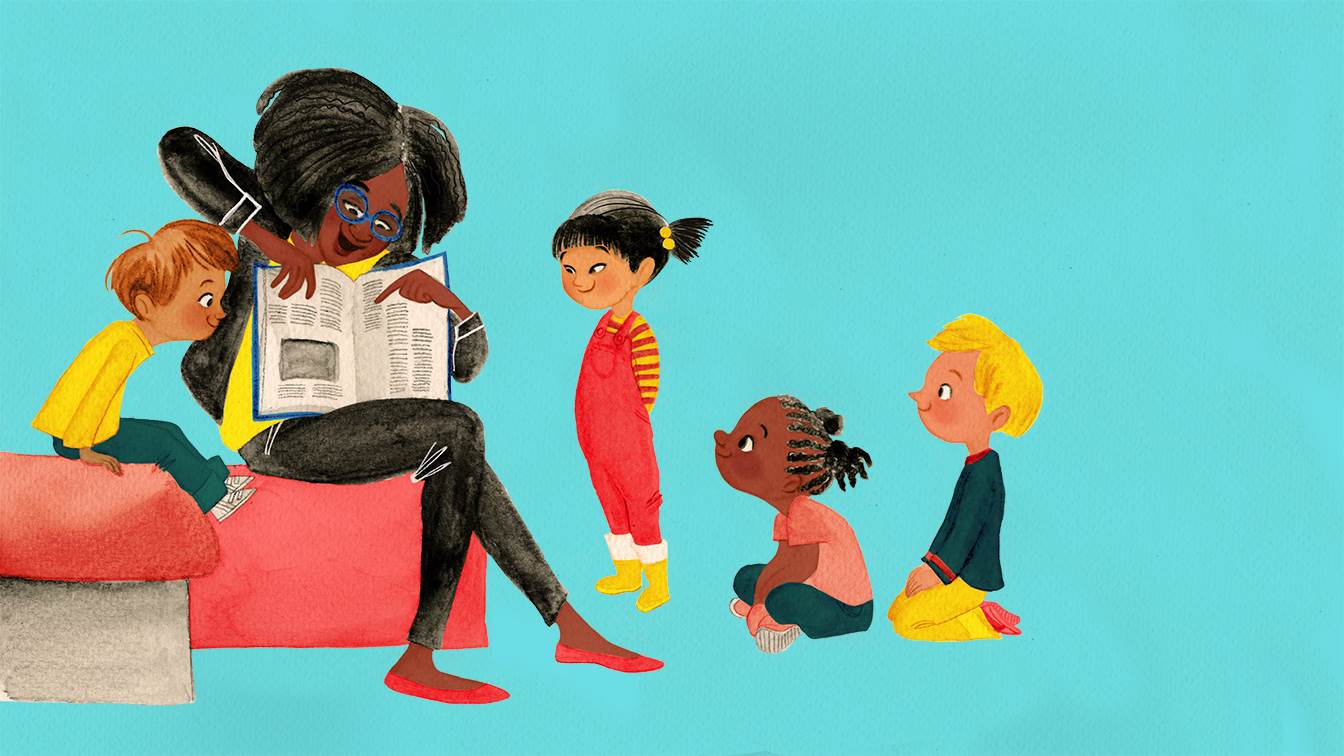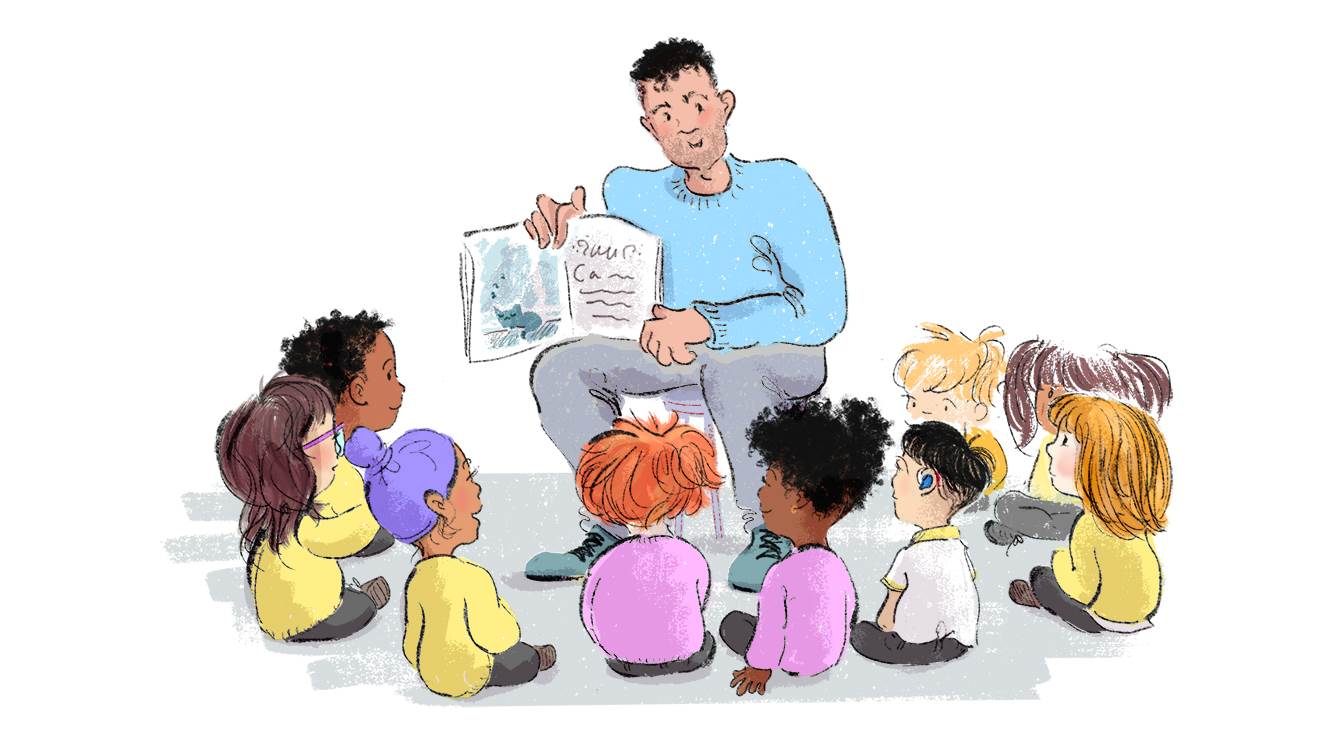Bringing books to life: Top tips for sharing stories from our Storytime Prize judge Zoey Dixon
Published on: 09 December 2020 Author: Zoey Dixon
Zoey Dixon, a librarian from London, helped to choose our Storytime Prize shortlist and then became a regional judge, sharing the nominees with families.
Now, she's sharing some top tips to help you make the most of storytime...

Illustration: Erika Meza
I've always loved having stories told to me, from my parents reading to me when I was a child to shared class readings at primary school and reading aloud our set texts for my English GCSE and A Levels.
So when I became a children's librarian, running the storytime sessions quickly became one of my favourite parts of the job. Children are never too young to join a storytime group, although I am asked this question by parents often, and babies can benefit just as much as toddlers from being read to, even in group settings.
'Enjoy yourself and have fun'
I wasn't always a good storyteller. I've learnt a lot over the years from watching my colleagues and other professional storytellers, picking up tips, watching YouTube videos and just practising.
My number one advice for telling a story, even if you're nervous and perhaps not very good yet, is to enjoy yourself and have fun! Choose a book that you like reading yourself and it will be easy for your enjoyment to come through.
Don't be afraid to do the voices... but also, it's okay if you can't do the voices! I will be the first to admit that I am not great at it - Rita, one of my colleagues, is fantastic and her performance of Karl Newson and Ross Collins' I am a Tiger is a joy to watch.
But that shouldn't stop you from being a good storyteller. The key is to use your voice effectively. Change your tone, change the volume - even the speed of how you read will allow you to voice different characters and differentiate between them. You can even get the children who can talk and the grown-ups to voice characters for you, so you are the narrator.

Pic: Kate Alizadeh
Don't be afraid to be silly! It does help if you are reading a particularly silly book - Oi Frog and the follow-ups by Kes Gray and Jim Field are good examples.
And you can add your own bits to the story - you don't just have to read what is on the page. Dear Zoo is a classic and fun lift the flap story by Rod Campbell, but I very rarely read it as it is. Not only do I get the kids to lift up the flaps, make the animal noises and do the actions, but I add to the story.
So that camel isn't just too grumpy, but it's grumpy and keeps spitting at me. The frog is far too jumpy - so jumpy that I couldn't catch it (that's another tip - watch out for automatically using 'he' pronouns). Add your own twists to bring a story alive - you can even include yourself or the kids in the book.
Getting children to interact with stories
Some of the books I turn to read again and again are the ones that encourage interaction and participation. But just because it seems that a story is more 'passive', it doesn't mean you have to read it like that. You can turn stories into interactive ones very easily by doing actions or making sounds.
I have loved Car, Car, Truck, Jeep and Go, Go, Pirate Boat by Katrina Charman and Nick Sharratt, because I have been singing stories for years.
One of my favourite stories to sing is Brown Bear, Brown Bear, What Do You See by Bill Martin, Jr. and Eric Carle to the tune of 'Frere Jacques'. This book is a great way to get kids and grown-ups engaged with a familiar story in a different way, using repetition and a call and response device:
What do you see?
What do you see?
Brown Bear
Brown Bear
I see a Red Bird
I see a Red Bird
Looking at Me
Looking at Me
Another favourite story is Where's My Teddy by Jez Alborough, sang to the tune of 'Michael Finnegan'. I sing some parts and speak the dialogue, and when Eddy stops quite still, I go silent for at least ten seconds - the reaction of the kids when I do this is fantastic to watch.
Of course, there is nothing better than just listening to a good story with beautiful illustrations, and Ezra Jack Keats' The Snowy Day is a book I always pull out, especially on the (rare) snow days we have in London - it stimulates the imagination.
Enjoying a variety of stories
When selecting which books I'm going to read for a session, I always make sure I'm including a mix of stories that represent the world and the children that I'm telling stories to. And we always show the adults the range of stories available - after all, we're a library, and we want them to take the books out after they fall in love with them during a session.
Luckily there are some fantastic picture books out there, and I have been fortunate enough to be involved with this year's BookTrust Storytime Prize, which highlights some of the best books for storytelling. The nominated books have now joined the (very large) list of my favourite books to use for storytelling.
Topics: Features, Storytime Prize, Reading Tips





Add a comment